 |
surfresearch.com.au
ancient hawaiian surfboards: #4 |
| home | catalogue | history | references | appendix |
|
3.1 One of
the earliest 19th century desciptions of a Hawaiian surfboard is an illustration
by Jacques Arago,
"The Houses of Kraimokou, circa 1819", who visited
the Hawaiian Islands when circumnavigating the world 1817 to 1820. (1)
A wonderfully detailed
illustration of Hawaiian dwelling with the chief in ceremonial dress and
his wife beating
tapa cloth, a large
Olo board takes a central position in the drawing and presumably a similar
culutural position.
Given the scale of
the illustration, the board is approximately 15 feet long, 20 inches wide
and,
less accuarately, three inches thick.
The template is
foiled with a round nose and square tail, the later possibly indicating
a convex bottom profile.
While the rails
appear square, this possiblly is an artistic compromise to give the board
perspective.
The print, below,
shows the board constructed from a light-toned timber, perhaps indicating
willi willi rather than the significantly darker koa wood.
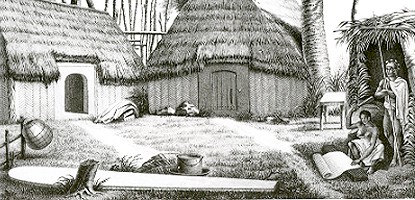 |
Engraving by Alphonse Pellion: "The Houses of Kraimokou", circa 1819. (2) Finney and Houston (1996) Page 37.. First image of an Olo board. |
The buildings closely
resemble a house initally drawn by John Webber in 1779 titled "An Offering
before Capt Cook in the Sandwich Ilses".
An engraving, based
on the drawing by S. Middleman and J. Hall, was included in Cook's
published journals in 1884. (4)
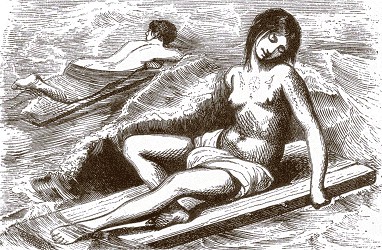 |
"Wahine, Hawaii", circa 1819. (4) Finney and Houston (1996) Page 38.
|
3.3 Ellis's
published account (4.1) included a drawing by F. Howard, titled "Sandwich
Island Surf-riders", circa 1830. (6)
Although it is probably
the first reported Western image of standing surfriding, correctly identifying
the stance, the depiction of the boards is crude and they appear, given
modern surfriding experience, to be too small for succesful riding.
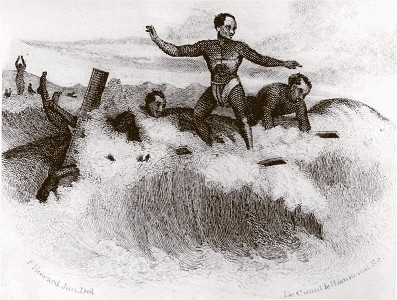 |
"Sandwich Island Surf-riders", circa 1830. (7) Finney and Houston (1996) Frontpiece. The first reported
Western image of surf-riding,
|
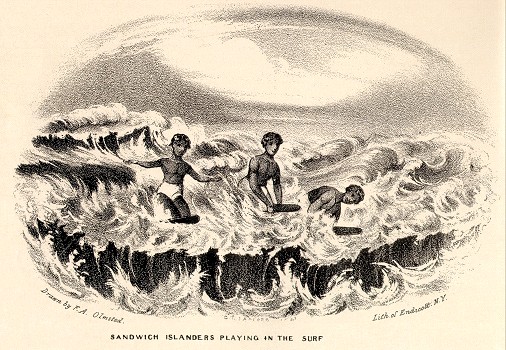 |
"Sandwich Islanders Playing in the Surf, circa 1841." (9) .Lueras (1984) Page 39. First image by the
same writer
|
Of the two, E. Riou's
(1833-1900) "Jeux Havaiens"
(Hawaiians playing) is a wide seascape
that views the boards from a considerable distance. (12)
Leuras (1984) page
52, notes that that the illustration has "a Tahiti-like backdrop"and
there are several standing riders apparently riding away from the beach.
There are some similarities
with Howard (1830), particually the attire.
At best, the boards
could be estimated as flat, six feet long and 20 inches wide.
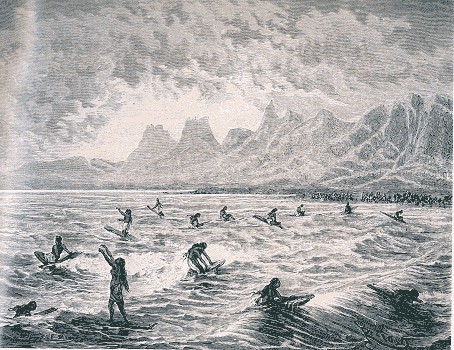 |
"Jeux Havaiens" (Hawaiians playing), circa 1873. (13) Lueras (1984) Page 53. Probably reconstructed
from reports
|
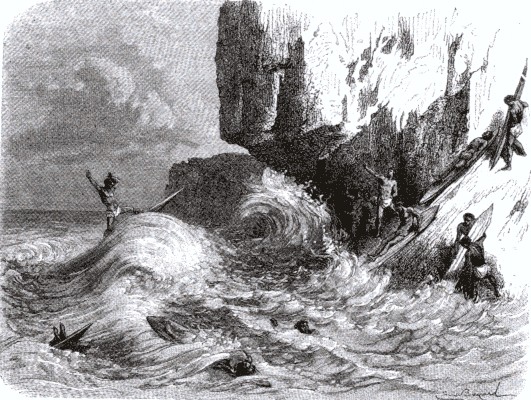 |
"Jeux Havaiens" (Hawaiians playing), circa 1873. (15) DelaVega (ed, 2004) Page17. Probably reconstructed from reports or sketches. |
|
1819 |
1819 |
1830 |
1871 |
1871 |
1873 |
|
| Location |
|
|
|
|
|
|
| Design |
|
|
|
|
||
| Length |
|
|
|
|
|
|
| Width |
|
|
|
|
|
|
| Thickness |
|
|
|
|
|
|
| Weight |
|
|
|
|
|
|
| Template |
|
|
|
|
|
|
| Nose |
|
|
|
|
|
|
| Tail |
|
|
|
|
|
|
| Rails |
|
|
|
|
|
|
De Rienzi, Domeny
(1789-1843) & Gregoire Louis
Oceanie; au cinquieme
partie du monde revue geogrophique et ethnogrophique de la Malaisie, de
la Micronesie, de la Polynesie et de la Melanesie; offrant les resultats
des voyages et des decouvertes de l'auteur et de ses devanciers, ainsi
que ses nouvelles classifications et divisions de ces con trees (The Universe,
History
and Description,
of All the People) 3 Volumes (Paris: Firmin Didot 1836-7) vol. 2, plate
115. "Habitations" Image of house and surfboard (See next page bottom).
French cultural anthropology book. No surfing content.
DelaVega page16
2. Finney
and Houston (1996) Page 37.
The image, in various
sizes and/or cropped versions, has been reproduced in many surfing books.
Finney
and Houston (1966) Plate 12.
Margan
and Finney (1971) Page 19
Nat's
History (1983) Page 33 Badly cropped.
Lueras
(1984) Page 35. Colourised, see below.
Kampion
: Stoked (1997) Page 31. Credited as "Kraimoku Homestead"
by Villroy. Bishop Museum.
Dela
Vega (ed, 2004) page 20.
3. Jacques
Arago (Engraving : ?) : "Wahine, Hawaii, circa 1819."
First printing
in :Arago, Jacques : Recollections of a Blind Man
An account of a
tour around the world, circa 1820.
4. Beaglehole,
J.C.: The Life of James Cook
Stanford University
Press Stanford, California. 1974.
Original publisher
: A. & C. Black, Ltd. London, 1974.
Plate 41, between
pages 672 and 673.
4. Finney
and Houston (1996) Page 38.
Various resized
and/or cropped versions are also printed in
Finney
and Houston (1966) Page 43, Figure 5.
Margan
and Finney (1971) Page 19.
5.The fascination
with the naked female breast can be, perhaps, assessed by a desciption
of a young aboriginal woman by Watkin Tench, a British Army officer posted
to the initial occupation of Australia at Sydney Cove in 1788.
"She excelled
in beauty all their females I ever saw.
Her age about
eighteen, the firmness, the symmetry and the luxuriancy of her bosom might
have tempted painting to copy its charms."
http://etext.library.adelaide.edu.au/t/tench/watkin/settlement/chapter17.html
Rendered into HTML
on Mon Nov 3 09:50:03 2003, by Steve Thomas for
The University of
Adelaide Library Electronic Texts Collection.
6. F. Howard
: "Sandwich Island Surf-riders", circa 1830.
Etching by W. Finden.
First published
... Rev. William Ellis
: Polynesian Researches, During a Residence of Nearly Eighty Years in the
Society and Sandwich Islands, Volumes I to IV..
Fisher, Son and
Jackson, London, 1831. Title page to Volume IV (?)
The first reported
Western image of surf-riding, it correctly identifies stance.
The "Sandwich Islands" was the name originally given to the Hawaiian Islands by Cook, for a patron, Lord Sandwich (as in the "invention" of a piece of meat between two slices of bread) and was used up to the late19th century.
7. Finney
and Houston (1996) Frontpiece.
Various resized
and/or cropped versions are also printed in
Finney
and Houston (1966) Frontpiece. A particually poor reproduction,
unlike the other images in this book.
George
(1990) Page 21.
Dela
Vega (ed, 2004) Pages 18 -19
8. Francis
Olmsted (drawing) : "Sandwich Islanders Playing in the Surf",
circa
1841.
Lithograph by Endicott,
New York.
First printing ...
Francis Olmsted, F.A. : Incidents of a Whaling Voyage...
Appleton and Co.,
NY, 1841. Page 222 or 223.
First image by the
same writer and artist.
9. Lueras
(1984) Page 39.
Various resized
and/or cropped versions are also printed in
Nat's
History (1983) Page 33
Dela
Vega (ed, 2004) page 24.
10. de Varigny,
Charles: "Quatorze Ans Aux Iles Sandwich (Iles Havai)" (Fourteen years
in the Sandwich Islands)
Le Tour du Monde
Volume II, 1873, Pages 224, 237and 238.
Reproduced in Dela
Vega (ed, 2004) Page17.
11. I have been unable to locate any record of Bayard or Riou, the illustrators of "Voyage Aux Iles Sandwich (Iles Havai)", visiting the Hawaiian Islands.
12. E. Riou
: "Jeux Havaiens" (Hawaiians playing), circa 1873.
The first
printing acompanied
de Varigny, Charles
: "Voyage Aux Iles
Sandwich (Iles Havai)"
Le Tour du Monde
(A French magazine) Volume II, 1873, Pages 224,237 or 238.
13. Lueras
(1984) Page 53.
Various resized
and/or cropped versions are also printed in
George
(1990) Pages 12 -13
Kampion
(1997) Page 42 - 13 (cropped).
14. Emile
Bayard : "Jeux Havaiens" (Hawaiians playing), circa 1873.
The first
printing acompanied
de Varigny, Charles
: "Voyage Aux Iles
Sandwich (Iles Havai)"
Le Tour du Monde
(A French magazine) Volume II, 1873, Pages 224,237 or 238.
15. DelaVega
(ed, 2004) Page17.
Various resized
and/or cropped versions are also printed in
Finney
and Houston (1996) Page 20
Margan
and Finney (1971) Page 14.
20. Knox,
Thomas W. (1835-1896) :The Boy Travellers in Australasia.
Adventures of
Two Youths in a Journey to the Sandwich, Marquesas, Sociey, Samoan and
Feejee
Islands and Through
the Colonies of New Zealand, New South Wales, Queensland, Victoria,
Tasmania and
South Australia.
New York Harper
& Brothers 1889.
Harper & Brothers
Publishers, 1902.
Charles Tuttle Co,
Rutland, Vermont & Tokyo, Japan. reprinted1971.
Paul Flesch &
Company, Melbourne.1971 pages ???

| home | catalogue | history | references | appendix |